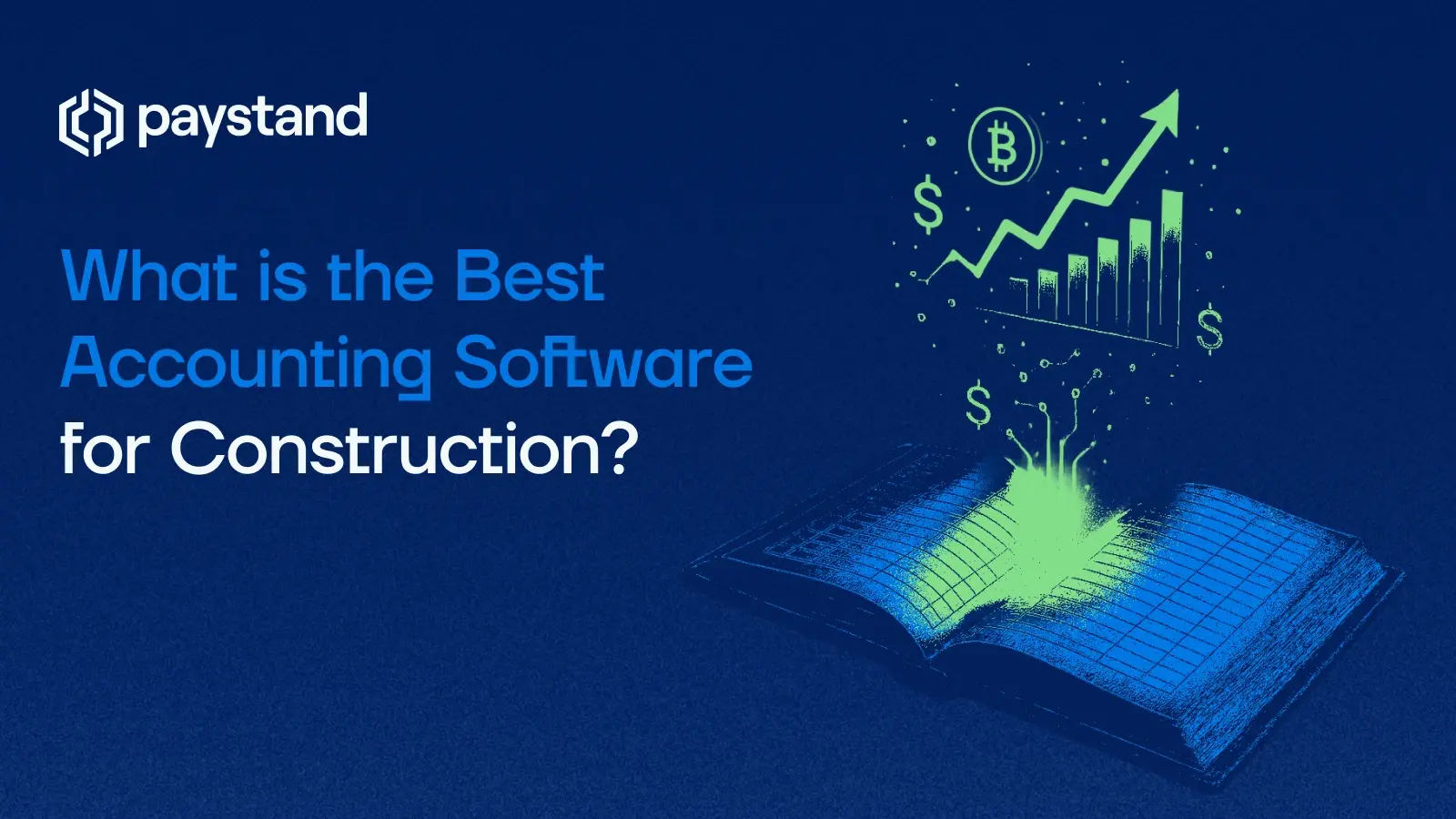What is the Best Accounting Software for Construction?

Table of Contents
- What is the best accounting software for construction?
- Construction accounting programs: how to choose wisely
- Why software alone isn’t enough anymore
- Reimagine construction payments with Paystand
Key Takeaways
- Construction accounting software is now a strategic foundation that impacts project timelines, cash flow, and long-term growth.
- The best software solution depends on your business size and complexity, with NetSuite, Dynamics, Acumatica, and Sage Intacct offering scalable, industry-specific features.
- Companies should prioritize scalability, real-time data, integration, and accessibility for finance teams and jobsite crews.
- Even the best accounting tools fall short without modern payment infrastructure; legacy payment methods like paper checks continue to stall progress and profitability.
- Paystand automates receivables, digitizes payments, and eliminates fees, transforming construction finance into a faster, smarter, more secure system.
In the construction industry, managing finances is often seen as a back-office chore: a necessary evil to keep operations running and crews paid. However, if your financial foundation is weak, the entire operation is at risk. Poor visibility into cash flow, delayed invoices, billing challenges, and outdated tools can slow projects significantly, and that's not considering the ongoing struggle between accounts payable and receivable.
Choosing the right construction accounting software is now a strategic decision. Whether you're a small residential team or a nationwide contractor, the right software helps track costs, manage job costing, and handle digital payments throughout the build.
Traditional systems have brought us far, but can they take us further? Are your tools helping you move money faster, smarter, and more transparently, or are they simply keeping you busy?
Let’s explore top accounting software for construction and examine the future of construction finance.
What Is the Best Accounting Software for Construction?
Ask ten builders what “best” means, and you’ll get ten different answers. The best accounting software for construction depends on fit, not brand names or features. Are you a small firm handling a few custom builds or a rapidly scaling operation managing many subcontractors and large projects?
This guide explores top solutions like QuickBooks, Xero, Acumatica, and Sage Intacct, highlighting their strengths, weaknesses, and ideal use cases. It also shows how modern tech such as Paystand helps construction businesses escape slow payment cycles and outdated banking systems.
NetSuite: Enterprise-Grade Power for Construction at Scale
If you're managing complex construction operations across multiple areas, NetSuite enhances your financial tech stack. This cloud-based ERP is more than just accounting software; it’s a fully integrated platform connecting project management, procurement, accounts payable, accounts receivable, and construction billing.
NetSuite provides construction companies real-time visibility into financial transactions, cash flow, and job costing across projects. Its automation handles thousands of transactions, complex approvals, and compliance reporting effortlessly.
Best for: Mid-sized to enterprise-level construction businesses looking for an end-to-end ERP system with deep financial automation, visibility, and scalability.
Microsoft Dynamics: Flexible Power for Complex Construction Needs
If your construction company is rapidly growing or operating at scale, Microsoft Dynamics 365 offers powerful tools beyond basic accounting. Options like Dynamics 365 Business Central for mid-sized firms and Dynamics 365 Finance for larger enterprises provide unmatched flexibility to manage accounts payable, accounts receivable, job costing, and project management in one environment.
Dynamics requires more initial setup than plug-and-play solutions but offers long-term value through its support for complex financial transactions, multi-entity operations, and advanced construction payment management. Additionally, it’s extensible with industry-specific add-ons for improved construction billing and real-time portfolio insights.
Best for: Mid-sized to enterprise construction companies seeking robust, integrated solutions with customizable features for financial and operational scale.
Acumatica: Construction Accounting with ERP Power
Acumatica accounting software is designed for builders requiring more than basic accounting. It serves as a comprehensive operational command center. Tailored for the construction industry, Acumatica’s Construction Edition integrates accounting, project management, CRM, and field service management.
It supports job costing, budget tracking, subcontractor management, and compliance monitoring. For complex operations, Acumatica is a game-changer. Its consumption-based pricing model means you’re not penalized for team growth.
Best for: Mid- to large-sized construction companies needing robust ERP capabilities with deep construction features.
Sage Intacct: Next-Level Accounting for Complex Operations
Sage Intacct is a high-performance engine for large-scale construction. This cloud-native platform offers automation, detailed reporting, and multi-entity support, all designed to scale. Providing deep financial visibility across projects, Sage Intacct is favored by CFOs and finance teams handling high volume and complexity.
The Sage Intacct marketplace offers pre-built integrations with major construction tools, allowing you to customize your stack without reinventing the wheel. If data accuracy, automation, and control are priorities, this option is worth considering.
Best for: Large construction firms or fast-growing enterprises with complex financial needs and established processes.
Construction Accounting Programs: How to Choose Wisely
When choosing between these construction accounting programs, your decision should revolve around more than just features. Here’s how to evaluate what’s right for your team:
- Scalability: Can the software grow with your business, or will you outgrow it in a year?
- Project-specific accounting: Does it support job costing, change orders, and detailed reporting by project or cost code?
- Real-time data: Are you getting up-to-date insights on budgets, margins, and financial transactions, or is everything lagging?
- Team accessibility: Will your field teams and finance staff actually use it? Or will it gather digital dust?
- Integration options: Can it plug into your existing tech stack, especially for digital payments, scheduling, and compliance?
Ultimately, good construction accounting software empowers you to manage risk, maximize profitability, and move faster in a highly competitive market. That means less time reconciling spreadsheets and more time building what matters.
Why Software Alone Isn’t Enough Anymore
Here’s the hard truth: even the best accounting software can’t fix the broken part of construction finance, which is payments. Late payments, long DSO cycles, and disconnected bank portals hinder industry progress. Many construction companies still rely on paper checks in 2025, making it inefficient.
That’s why many forward-thinking construction firms are turning to financial infrastructure platforms like Paystand, not to replace their accounting software, but to supercharge it.
Reimagine Construction Payments with Paystand
While traditional tools handle invoicing and reporting, Paystand transforms how money moves. It integrates directly with ERP and accounting platforms like QuickBooks, Acumatica, and Sage Intacct to eliminate payment bottlenecks, automate accounts receivable, and reduce reliance on credit cards and paper checks.
With Paystand, you can:
- Automate receivables: Trigger workflows that send invoices, reminders, and payment links without lifting a finger.
- Digitize B2B payments: Accept zero-fee bank transfers, ACH, RTP, or card payments through a branded self-serve portal.
- Simplify reconciliation: Payments sync automatically with your ERP, giving you real-time visibility into collections and cash flow.
- Improve cash conversion cycles: Faster payments mean fewer delays, healthier balance sheets, and fewer construction billing challenges.
- Modernize security with blockchain: All transactions are recorded immutably for transparency, fraud prevention, and audit-readiness.
Paystand isn’t just an add-on. It’s a statement. A way to show clients, subcontractors, and your finance team that you’re done waiting on legacy systems. That you’re ready for construction payment management to catch up with the rest of your digital operations.
And here’s the kicker: when you eliminate fees, automate collections, and streamline approvals, you're not just saving time; you’re reclaiming capital and reinvesting in what truly matters: your people, your projects, and your growth.
Don’t Just Balance the Books; Rebuild the System
The construction industry is building the future. But when it comes to finance, we’ve settled for systems built in the past. If your team is still operating on paper invoices and outdated accounting workflows, it’s time to rethink what’s possible.
Yes, it starts with choosing the right software. But it doesn’t end there.
It ends when your financial operations are as modern, automated, and mission-driven as the buildings you create. It ends when you stop chasing payments and start building wealth on your terms.
If you haven’t entered the new financial era, here’s your blueprint. Are you ready to lay the groundwork for something better? Are you still patching the cracks in the old system?
See how Paystand helps construction companies modernize their payments and build finance operations that are ready for the next generation of growth.






